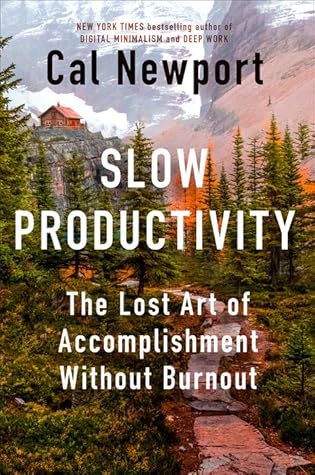More on this book
Community
Kindle Notes & Highlights
by
Cal Newport
Read between
August 6 - August 11, 2024
The relentless overload that’s wearing us down is generated by a belief that “good” work requires increasing busyness—faster responses to email and chats, more meetings, more tasks, more hours. But
A philosophy for organizing knowledge work efforts in a sustainable and meaningful manner, based on the following three principles: 1. Do fewer things. 2. Work at a natural pace. 3. Obsess over quality.
this philosophy rejects busyness, seeing overload as an obstacle to producing results that matter, not a badge of pride. It also posits that professional efforts should unfold at a more varied and humane pace, with hard periods counterbalanced by relaxation at many different timescales, and that a focus on impressive quality, not performative activity, should underpin everything.
I want to rescue knowledge work from its increasingly untenable freneticism and rebuild it into something more sustainable and humane, enabling you to create things you’re proud of without requiring you to grind yourself down along the way.
I think that’s where the burnout really hurts—when you want to care about something but you’re removed from the capacity to do the thing or do it properly and give it your passion and full attention and creativity because you’re expected to do so many other things.
To embrace slow productivity, in other words, is to reorient your work to be a source of meaning instead of overwhelm, while still maintaining the ability to produce valuable output.
Humans derive great satisfaction from being good at what they do and producing useful things. This philosophy can be understood as providing a more sustainable path toward these achievements.
Slow productivity supports legacy-building accomplishments but allows them to unfold at a more human speed.
Strive to reduce your obligations to the point where you can easily imagine accomplishing them with time to spare. Leverage this reduced load to more fully embrace and advance the small number of projects that matter most.
Slack chatter.
Zoom Apocalypse.
The advantage of doing fewer things, however, is about more than just increasing the raw number of hours dedicated to useful activity; the quality of these hours also increases.
doing fewer things makes us better at our jobs; not only psychologically, but
Focusing intensely on a small number of tasks, waiting to finish each before bringing on something new, is objectively a much better way to use our brains to produce valuable output.
that toiling at maximum capacity greatly reduces the rate at which we accomplish useful things, as it chokes our schedule in administrative kudzu and splinters our attention into fragments too small to support original thinking.
taming the impact of small details in your professional life opens up space to pursue bigger goals.
Small tasks, in sufficient quantity, can act like productivity termites, destabilizing the whole foundation of what you’re trying to build. It’s worth going to great lengths to tame them.
In many cases, it’s not the actual execution of a small commitment that generates distraction, it’s instead the cognitive effort required to remember it, to worry about it, and to eventually find time for it in your schedule.
PUT TASKS ON AUTOPILOT
Once you get used to accomplishing a specific type of task at the same times on the same days, the overhead required for their execution plummets.
ritual and location makes it more likely
MAKE OTHER PEOPLE WORK MORE
AVOID TASK ENGINES
their work is corroding away all the other attributes of their existence.
SIMULATED PULL, PART 1: HOLDING TANK AND ACTIVE LISTS
SIMULATED PULL, PART 2: INTAKE PROCEDURE
acknowledgment message that formally acknowledges the project that you’re
(1) a request for any additional details you need from the source before you can start the project, (2) a count of the number of existing projects already on your lists, and (3) an estimate of when you expect to complete this new work.
SIMULATED PULL, PART 3: LIST CLEANING
it’s often our own anxieties that play the role of the fiercest taskmaster.
If you instead give yourself more than enough time to accomplish your objectives, the pace of your work can fall into a more natural groove.
whatever timelines you first identify as reasonable for upcoming projects, and then double their length.
The key to meaningful work is in the decision to keep returning to the efforts you find important. Not in getting everything right every time.
A clever way to balance this stress is to pair each major work project with a corresponding rest project. The idea is simple: after putting aside time on your calendar for a major work project, schedule in the days or weeks immediately following it time to pursue something leisurely and unrelated to your work.
The trick, of course, is in identifying your own personalized version of Mary Oliver’s long walks through the woods.
Obsess over the quality of what you produce, even if this means missing opportunities in the short term. Leverage the value of these results to gain more and more freedom in your efforts over the long term.
This is what ultimately matters: where you end up, not the speed at which you get there, or the number of people you impress with your jittery busyness along the way.


